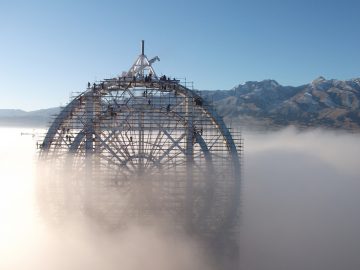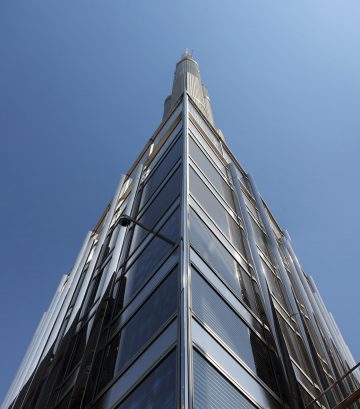Standard, rectilinear buildings are by no means the norm in today’s world, and we are seeing architects develop more iconic and unique buildings with unusual forms and shapes as well as intricate facade designs and features.
Of course, facade access is still an unavoidable necessity in order to maintain any building, and some facade types present particular challenges to effective, comprehensive and safe cleaning and replacements. As leaders in the industry, CoxGomyl have been at the forefront of developing BMUs and facade access systems to overcome the challenges that complex facades can present.
Overhangs, arches and voids
Providing full access to these architectural features can be particularly challenging. However, manoeuvring through negative or reverse positions to access the underside of arches or overhangs can be safely completed in a number of ways. Upside mounted BMUs can be suspended from tracks under the soffits, or an articulated jib can be secured to the roof and travel underneath an arch. Soft rope solutions can allow the cradle to move horizontally across the face of the building and navigate deep recesses or voids whilst remaining securely restrained.
Limited Roof Space
Where space on the roof is too limited for a traditional BMU, there are a number of solutions that we can provide. A monorail system can be installed on an aluminium track fixed to the side of the building or hung from under a recess. The track can be run around corners or light curves in the facade. Alternatively, davit systems consisting of aluminium or steel arms can be dismantled and moved to access a different area of the building. After use, the davits and the cradle can be stored in dedicated areas either on the ground or on the roof.
Sloping facade surfaces
One of the key developments over the past 20 years is the in-built self-levelling mechanism that helps machines climb surfaces and uneven pitches. This allows access to sloping surfaces without jeopardising the stability of the cradle.
Irregular building shapes
Perhaps one of the most challenging facades was the world’s tallest building, The Burj Khalifa in the UAE. It features intricate Islamic patterns incorporated throughout the structure, with a unique tri-petal shaped footprint and no roof space, making standard BMU solutions unworkable. In this instance, CoxGomyl’s solution included three wall-mounted machines running on curved tracks which match the unique shape of the building itself. This project also earnt CoxGomyl a place as finalist in the BMU Innovation Award. The judges highlighted, in particular, how the curved tracks provided an elegant solution which integrated the access system seamlessly with the facade of the building.
Whatever the challenges presented by the most complex or unusual facade, CoxGomyl has the experience and expertise in our team to ensure all of your facade access and design needs are met.
Back to News
